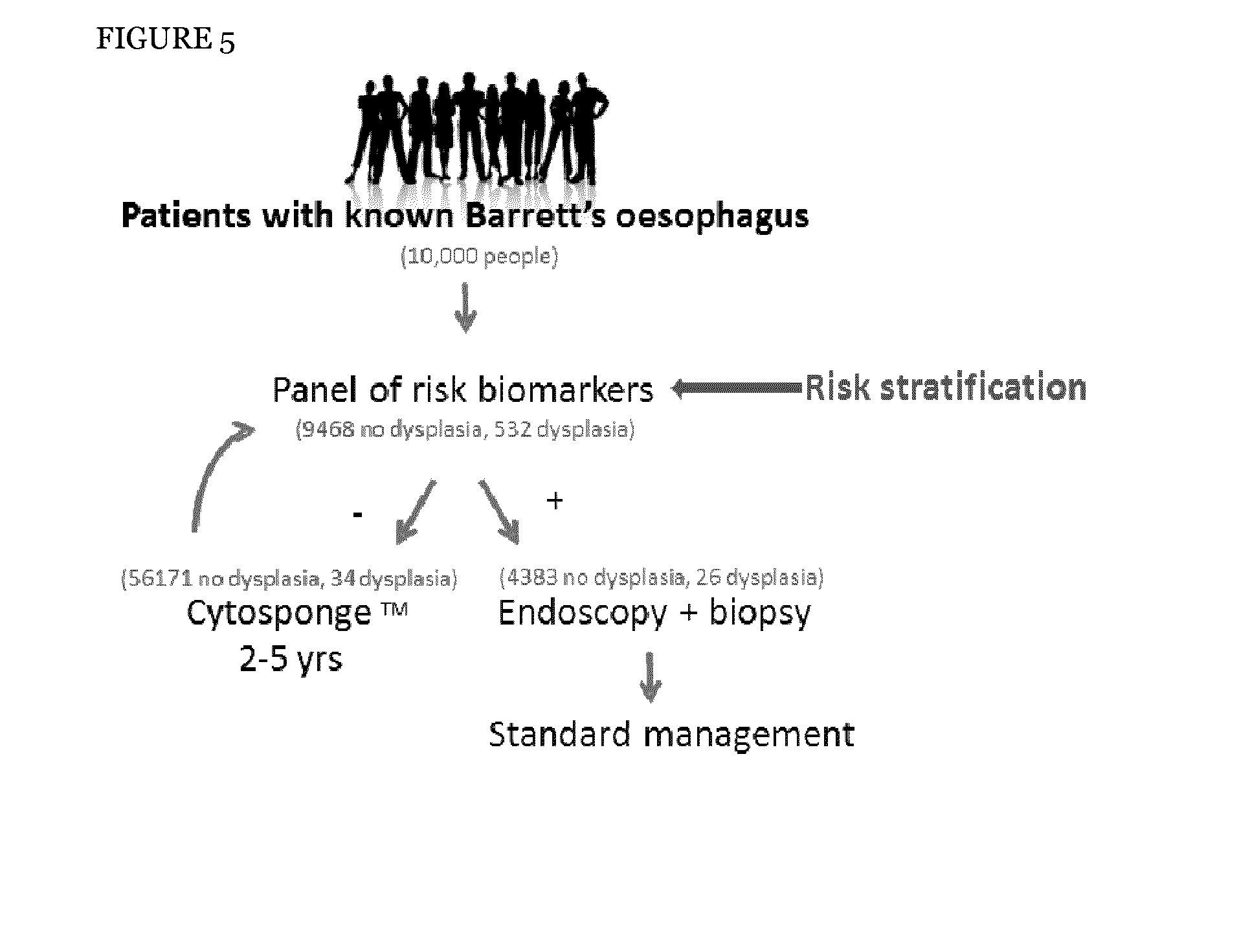Method and apparatus of aiding detection of surface abnormality in the oesophagus
a technology of oesophagus and surface abnormality, which is applied in the direction of nucleotide libraries, instruments, library screening, etc., can solve the problems of small work on the precise ordering of these alterations in large cohorts, associated clinical follow-up data, and striking and unexpected findings
- Summary
- Abstract
- Description
- Claims
- Application Information
AI Technical Summary
Benefits of technology
Problems solved by technology
Method used
Image
Examples
example 1
Selection of Markers
[0313]There were a number of reasons for selecting the four molecular risk stratification biomarkers, (optionally plus a fifth marker atypia), examples of which are set out below:
[0314]p53 protein accumulation was selected as a biomarker as p53 is one of the best characterised tumour suppressor proteins and has been shown to be associated with dysplasia in Barrett's oesophagus (Bian et al., 2001) as well as with increased risk of progression to OAC (Kastelein et al., 2012; Sikkema et al., 2009).
[0315]c-MYC, a well characterised oncogene, was included as it is recurrently amplified in OAC (Miller et al., 2003; Rygiel et al., 2008) and displays increased gene expression in Barrett's with high grade dysplasia in our in-house gene expression arrays.
[0316]Aurora kinase A (AURKA) was selected as a surrogate marker of aneuploidy as AURKA overexpression, centrosome amplification and aneuploidy have been shown to be associated. AURKA is a key regulator of mitotic entry, c...
example 2
Exclusion of Markers
[0318]There are robust reasons for excluding other potential biomarkers for use on the Cytosponge™. Some examples of markers excluded from the design of the panel are discussed below:
[0319]Eleven other potential biomarkers were evaluated to determine whether these could be used in conjunction with the Cytosponge™ to detect Barrett's with dysplasia. The 11 biomarkers were EGFR, CDNK2A, FGFR2, CCNA1, DDX21, MSLN, PLK1, HER2, DNMT1, MYHFD2 and VNN2. EGFR, HER2, CDNK2A, CCNA1 and FGFR2 were selected from published literature and DDX21, MSLN, PLK1, DNMT1, MTHFD2 and VNN2 were selected from in-house gene expression array data. VNN2 was eliminated as there are no antibodies available for staining formalin fixed paraffin embedded (FFPE) slides for this protein. FGFR2 and CDKN2A were eliminated as expression of both these proteins was detected in gastric glandular tissue which would also be sampled by the Cytosponge™. MTHFD2 was excluded as the staining was only cytoplasm...
example 3
Sample Processing and Preparation
Processing of the Capsule Sponge Specimens
[0325]Cytosponge™ capsules were swallowed by patients and then placed directly into preservative solution at 4° C. until processed further. The samples were vortexed extensively and shaken vigorously to remove any cells from the sponge material. The preservative liquid containing the cells was centrifuged at 1000 RPM for 5 minutes to pellet the cells. The resulting pellet was re-suspended in 500 μL of plasma and thrombin (Diagnostic reagents, Oxford, UK) was then added in 10 μL increments until a clot formed. The clot was then placed in formalin for 24 h prior to processing into a paraffin block. The sample was cut into 3.5 μm sections to provide 15 slides, named slides 1 to 15, with two sections placed on slide 1 and 2.
PUM
| Property | Measurement | Unit |
|---|---|---|
| morphology | aaaaa | aaaaa |
| affinity | aaaaa | aaaaa |
| nucleic acid | aaaaa | aaaaa |
Abstract
Description
Claims
Application Information
 Login to View More
Login to View More - R&D
- Intellectual Property
- Life Sciences
- Materials
- Tech Scout
- Unparalleled Data Quality
- Higher Quality Content
- 60% Fewer Hallucinations
Browse by: Latest US Patents, China's latest patents, Technical Efficacy Thesaurus, Application Domain, Technology Topic, Popular Technical Reports.
© 2025 PatSnap. All rights reserved.Legal|Privacy policy|Modern Slavery Act Transparency Statement|Sitemap|About US| Contact US: help@patsnap.com



